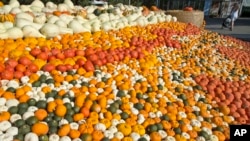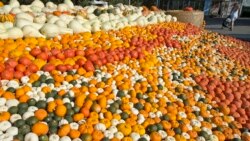From VOA Learning English, this is the Health & Lifestyle report.
There is one food that takes center stage during autumn – the pumpkin!
Many people use this orange gourd as a decoration at Halloween.
But we also use it in many foods that are popular during the fall season – foods like pumpkin bread, pumpkin coffee, pumpkin cookies, pasta made with pumpkin and pumpkin pie. In fact, pumpkin pie is one of THE most common desserts at an American Thanksgiving table.
But perhaps we should try to eat pumpkin all year long, and not just in the fall.
Pumpkins are packed with important nutrients and vitamins. If cooked in a healthy way, meaning without much butter or sugar, pumpkin is a powerhouse of health benefits.
Pumpkin is good for your eyesight
The nutrient beta-carotene and Vitamin A are necessary for maintaining good eyesight. Pumpkins are a great source of both. In fact, one nutrition website says that one cup of cooked, mashed pumpkin can give you more than 200 percent of your daily recommended amount of Vitamin A.
Pumpkin may help reduce your risk of getting cancer
The National Cancer Institute in the United States says on its website that antioxidants may help reduce a person’s risk of getting cancer. That is because antioxidants neutralize something called free radicals in the body. The Institute defines free radicals as “highly reactive chemicals that have the potential to harm cells.”
Antioxidants help to get rid of these free radicals. Examples of antioxidants found in food include beta-carotene, lycopene, and vitamins A, C, and E. And as we said earlier, pumpkin is full of beta-carotene as well as vitamin A.
Pumpkin helps your skin
Beta-carotene also helps to keep your skin healthy and young-looking. Yet another good reason to eat pumpkin!
Pumpkin may help your heart
Pumpkin is also loaded with potassium. Health experts say that consuming potassium may help treat hypertension or high blood pressure, just as decreasing your intake of sodium does.
Pumpkin may be good for weight loss
Pumpkin also has a lot of fiber. Fiber slows down digestion of food. So, when you eat pumpkin you feel full and eat less.
So, if it is available where you live, try to find ways to include pumpkin in your next meal.
And that’s the Health & Lifestyle report. I’m Anna Matteo.
Do you have pumpkin where you live? If so, how do you eat it? Share a recipe in the Comments Section!
_______________________________________________________________
Quiz
Now, test your understanding by taking this short quiz.
______________________________________________________________
Words in This Story
center stage – n. a central or highly prominent position
gourd – n. any of a family (Cucurbitaceae, the gourd family) of chiefly herbaceous tendril-bearing vines including the cucumber, melon, squash, and pumpkin
dessert – n. a usually sweet course or dish (as of pastry or ice cream) usually served at the end of a meal
powerhouse – n. someone or something that is full of a particular thing : <Seaweed is a powerhouse of vitamins and minerals.>
maintain – v. to keep in an existing state
mash – v. to reduce to a soft pulpy state by beating or pressure
potential – adj. capable of becoming real
intake – n. the amount of something (such as food or drink) that is taken into your body
sodium – n. a soft silver-white element that is found in salt, baking soda, and other compounds








